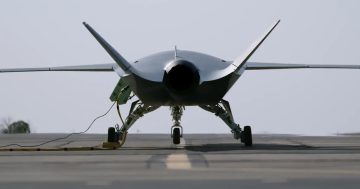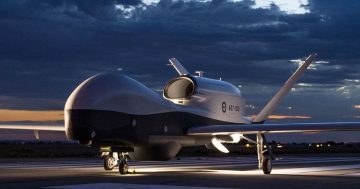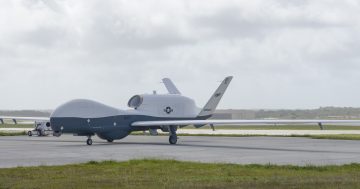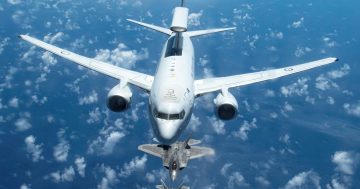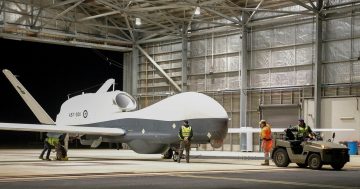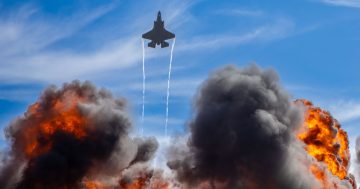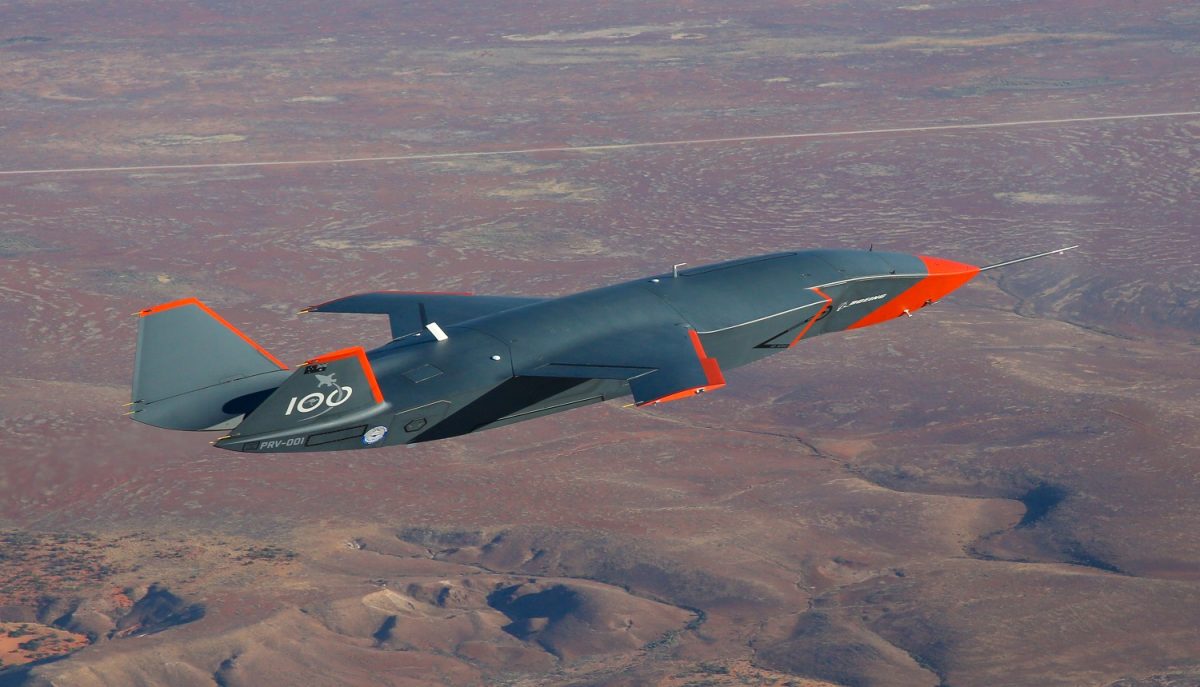
An MQ-28A during its first flight at Woomera in February 2021. Photo: ADF.
An Australian-designed and built uncrewed combat air system is attracting increasing interest from potential international customers, particularly the US and the UK.
Partially funded by the Royal Australian Air Force’s (RAAF’S) non-capitalised DEF 6114 Loyal Wingman program, the MQ-28A Ghost Bat was designed in Brisbane by a Boeing Defence Australia and Phantom Works International team, and was unveiled at the 2019 Avalon Air Show near Melbourne, for which your reporter had a world exclusive.
Based on Boeing’s Airpower Teaming System (ATS), the Ghost Bat is designed to carry a variety of sensors, non-kinetic, and kinetic payloads. As the Loyal Wingman and ATS names suggest, the aircraft was originally designed to support crewed aircraft, whether they be fighters, reconnaissance, command and control, or other high-value assets such as tankers.
Rather than be fully autonomous, the original mission set for the MQ-28A will see it operated in a Manned-Unmanned Teaming (MUM-T) role, where the Ghost Bat will be paired with a crewed aircraft, and that crew will task it accordingly. That doesn’t necessarily mean the two aircraft will be flying in formation – this could be done over distances of dozens or even hundreds of kilometres.
The MQ-28A itself is about the size of a small fighter jet and features low observable, or stealthy shaping, and composite materials that make it difficult to see and track on radar. The aircraft is powered by a single turbofan engine in the 8000 lbs thrust class, can fly at or close to the speed of sound, and has a range of more than 2000km.
One of the Ghost Bat’s key features is its detachable and interchangeable nose section, which houses sensor payloads. These sensors could be radar-based, electro-optical/infrared (EO/IR), or electronic intelligence (ELINT) payloads, or the nose could be configured with an active electronic warfare system designed to disrupt enemy radar systems and communications.

A graphic showing the Ghost Bat’s interchangeable noses containing different sensors. Image: Boeing.
The RAAF hasn’t spoken about potential armaments, but it is believed the MQ-28A will be capable of carrying precision-guided air-to-air and air-to-surface weapons on centreline and wing pylons.
The MQ-28A made its first flight at the Woomera Test Range in South Australia in February 2021 after a six-month delay due to the pandemic.
But, since then, the program has gone very quiet. Despite a test aircraft being on static display at the 2023 Avalon Airshow, neither the RAAF nor Boeing was able to comment on the flight test program’s status. Region Media sent a request in late May for an update on the program, but was told: “Defence will politely decline on this occasion.”
It is believed about 10 MQ-28As have been built or are under contract for the development program but, as one Defence insider recently told your reporter, “We know it did a few take-offs and landings, and followed some pre-programmed waypoints, then it all went dark!”
One reason for this could be the involvement of the US Air Force (USAF) in the program.
The only public mention of the MQ-28A in recent time was a short paragraph in April’s Defence Strategic Review (DSR), which said the system would continue to be developed in partnership with the US. This could mean one of two things – either we need the expertise of the US to help get the system to an operationally-ready status, or the USAF has an interest in the Ghost Bat itself.
The USAF has many uncrewed programs, some of which reside in the ”black” world, which will likely not be known about for decades. But one that is known is the Low-Cost Attritable Aircraft Technology (LCAAT) project. Formerly named Skyborg, several demonstrators have taken part in the program, including the General Atomics MQ-20, Kratos XQ-58A, Northrop Grumman with its manned surrogate Model 401 aircraft, and no doubt others that are yet to be revealed.
Late last year, one of Boeing’s MQ-28As was flown to the US in an RAAF transport for testing, reportedly out of the secretive Tonopah Test Range about 200km north of Las Vegas, not far from the even more secretive Area 51. Despite the aircraft making its public debut last month at a Boeing test facility near St Louis, the status of the MQ-28A program remains somewhat of a mystery.
One of the items listed among the Pillar 2 goals of the AUKUS agreement with the US and the UK was autonomous systems, so the Ghost Bat could have been sucked into that vortex and possibly elevated to a new level of classification.
There is little information on any possible UK involvement, although UK-based BAE Systems is known to have provided much of the autonomous ”smarts” as a supplier to Boeing and is considered one of the leading uncrewed systems innovators in the world today.
The UK Ministry of Defence has also shown various artists’ concepts of potential future uncrewed systems applications for both the Royal Air Force and Royal Navy and has used the Ghost Bat as an exemplar system.

A May 2023 photo taken in the US of an MQ-28A (left) alongside a US Navy MQ-25 uncrewed air-to-air refuelling system currently also in development. Photo: Boeing.












